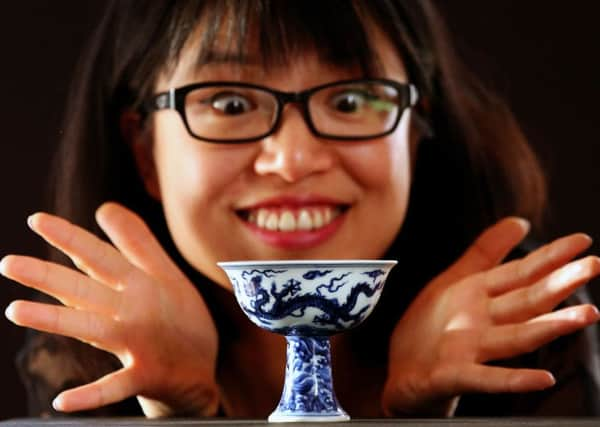£2m Ming Xuande dynasty china cup goes on show in Edinburgh


The Stem Cup was made around 1425, during the Ming Xuande dynasty, and features a five-clawed dragon flying through flames in pursuit of the eternally flaming pearl.
The “rare masterpiece” will be sold by auctioneers Lyon & Turnbull at a specially curated sale of Chinese Works of Art in Hong Kong on May 31.
Advertisement
Hide AdAdvertisement
Hide AdIt will be shown in Edinburgh before being previewed in America by Lyon & Turnbull’s sister company and America’s oldest auction house, Freeman’s of Philadelphia, and then transported to Hong Kong for sale.
Lee Young, head of Asian art at Lyon & Turnbull, said: “The Ming Xuande (1426-35) mark and period blue and white Stem Cup is a rare masterpiece and, of its type, is virtually unseen outside museum collections.
“The motif of flying dragons was popular in the Yuan dynasty, but was revived in the Xuande dynasty as can be seen in this case.
“The fearsome five-clawed dragon flies among flames, chasing the eternally flaming pearl, above a sea with crashing waves tipped in white, with rocks seen around the base.”
Advertisement
Hide AdAdvertisement
Hide AdThe Stem Cup was the most valuable of 270 items bequeathed to Staffordshire University in 1944 by Mr Ernest Thornhill, a pharmacist from London who collected Oriental ceramics. His collection was originally sent to the then North Staffordshire Technical College during wartime to be kept safe, but it remained hidden away in storage for years.
When it was rediscovered the university appointed Lyon & Turnbull to sell the Stem Cup to raise funds to build a permanent new home for the remainder of the collection at its Stoke-on-Trent campus.
This resource centre will enable student access to the collection for their study, complying with the original bequest and wishes of Mr Thornhill.
Lyon & Turnbull spokeswoman Grace Browne said: “It is an imperial piece, highly likely to have been handled by the emperor and therefore highly prized.
Advertisement
Hide AdAdvertisement
Hide Ad“No other examples of its quality are known to be on the open market. Other comparables are virtually unseen out of museum collections.
“Leading specialists regard the Stem Cup as the most important piece of porcelain to come out of the UK in the last ten years.”
Zhu Zhanji was the eldest son of the Hongxi Emperor and Empress Chengxiaozhao.
He ruled over a peaceful period and was fond of art, poetry and literature, although he did execute his uncle Zhu Gaoxu (the Prince of Han), his sons and 600 officials after a failed revolt.
The Xuande Emperor died of illness in 1435 after ruling for ten years. Historians have considered his reign to constitute the Ming dynasty’s golden age.